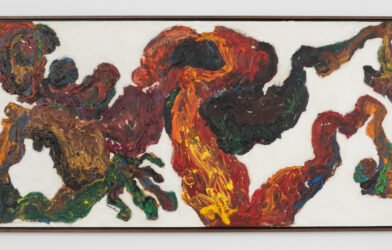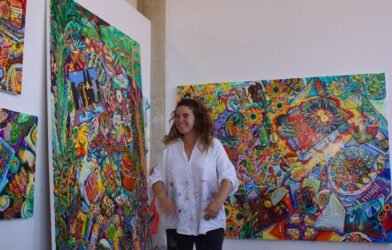Deep within the cavernous Arsenale di Venezia, amidst hundreds of works on view at the 60th edition of the Biennale, two paintings by Peruvian artist Violeta Quispe offer an invitation into a queer, gender-breaking multiverse. The works — El Matrimonio de la Chola (2022) and Apu Suyos (2024) — are a patchwork of nearly 100 characters pulled from Andean traditions of Quechua culture, recontextualized and filtered through a prism of sexual and gender equity. The inspiration for these colorful pieces comes from an adolescence spent navigating Lima’s deep conservatism.
“This led me to ask myself, where do I place myself in the nature of a society where ‘those minorities’ are found and marked by the society of a country that, unfortunately, still has patriarchal, racist, classist, homophobic and sexist thinking?” Quispe told ARTnews in a recent interview. “My origin is part of my blood, my touch, my art, my customs and my identity.”
This question of placement (or, more often, displacement) forms the core of Quispe’s work, but could also serve as a subheading for the exhibition’s central theme: “Stranieri Ovunque – Foreigners Everywhere.” It’s a concept that the Biennale’s curator, Adriano Pedrosa, knows well. As the first Latin American and first openly queer person to lead the famed exhibition, foreignness and identity have been at the top of his mind. But so, too, has beauty. Specifically, as his curatorial statement explains: “A foreign, strange, uncanny, and queer sort of beauty.” Constructing an exhibition full of this exact kind of beauty was the only directive he’d received when former president Roberto Cicutto appointed him artistic director in late 2022. After exploring the exhibition over two balmy days in early June, it seems Pedrosa’s mission was accomplished, mostly. There is beauty, strangeness, uncanniness, and, yes, queerness to this year’s Biennale.
“Foreigners Everywhere” is a particularly salient topic for exploring queerness. History is overflowing with all manner of LGBTQ people from all corners of the world. As Pedrosa’s statement notes, the figure of the Queer Artist “who has moved within different sexualities and genders, often being persecuted or outlawed” is integral to his grand vision. Of the 331 participating artists and collectives, there are dozens for whom queerness permeates their practices. These artists are often presented in clusters. There is a large “queer room” (as one Biennale attendant referred to it) at the back of the Arsenale’s Corderie, which gathers works by artists from Canada, China, Hong Kong, India, Mexico, Nicaragua, Pakistan, Peru, the Philippines, South Africa, and the USA. In the Central Pavilion, there are abstract works by queer artists from China, Italy, and the Philippines, while a small space near the entrance shows two congruous black-and-white photo series — Colombian artist Miguel Ángel Rojas’ El Emperador (1973–1980) and El Negro (1979) and Berlin-based artist Dean Sameshima’s being alone (2022) — staged next to a public restroom. While those works are a cheeky nod to both artists’ voyeuristic foci on cruising spaces, Sameshima’s paintings, Anonymous Homosexual in the Central Pavilion and Anonymous Faggot in the Arsenale’s Corderie, tap into broader themes of history and obfuscation in the Biennale’s queer offerings.
“The paintings are an homage to all the queers who are no longer with us and for those who can’t be out and fully themselves yet,” Sameshima told ARTnews.

An installation shot of works from the being alone series by Dean Sameshima.
Matteo de Mayda/Courtesy of La Bienniale de Venezia
Homage is also key to the work of Seoul-born, Los Angeles-based artist Kang Seung Lee, whose impressive Untitled (Constellation) stretches across the floor and up the walls a few rooms away in the Central Pavilion. A mix of drawing, embroidery, installation, and reappropriated organic materials and objects combine to pay homage to a generation of artists cut down by the AIDS crisis; forgotten figures such as Goh Choo San, Tseng Kwong Chi, Martin Wong, José Leonilson, and Joon-soo Oh are woven into her narrative.
“Histories are very often transnational,” Lee told ARTnews. “By talking about the legacy of these artists, who are from different continents, cities, and locations, I wanted [to] create a queer genealogy that has not been recognized enough by mainstream history.”
“I have always understood that our thinking or artmaking is influenced by people [who] came before us. In that regard, almost everything we do is not just our own but comes from the knowledge and histories that were created before us.”
For Lee, this idea of “foreignness” became “an invitation to consider that we are all ‘visitors’ to this world and are here temporarily. In this way, it’s also about suggesting new possibilities to relate to one another and start a conversation.”
Conversation and community center Chinese artist Isaac Chong Wai’s deeply personal seven-channel video series In Falling Reversely (2021–2024), located in the Arsenale’s Corderie. The piece, borne out of an attack against Chong Wai near a construction site, features the artist and a group of dancers moving as one communal unit, reacting to a body falling. Viewers sometimes see performers fall in a circle, or else reenact, reverse, and slow down the movement of falling, “referencing CCTV footnotes of people who have fallen in public spaces due to physical assault.” Violence is a throughline in many of the artist’s works, but Chong Wai notes that his practice has helped recontextualize the darkness.
“These violent incidents occur in the blink of an eye, and the speed of violence prompts me to use artistic practice to slow it down,” he told ARTnews. “Creating art has become a way to construct a different narrative — one where the aggressor’s belief in their inherent right to impose violence on others is removed.”
A few rooms away, Lebanese artist Omar Mismar presents Two Unidentified Lovers in a Mirror (2023), a mosaic work of two lovers that notably obscures their faces through tesseracted tiles. “The reshuffling of the tesserae messes the faces up, maims them,” he told ARTnews, but it also “protects the identities of the lovers while furnishing their faces as screens onto which other faces can be projected. It is reminiscent of covering or pixelating one’s face on dating apps and platforms, especially for fear of persecution or for wanting to remain anonymous.” The work commands attention, leading many viewers to pause for reflection in front of it (and, often, take a quick photo). For Mismar, overtness was key: “I craved a non-oblique, assertive moment, where homoeroticism is not subtly hinted at but, rather, unabashedly portrayed without the codes of myth or symbolism.”

Omar Mismar, Two Unidentified Lovers in a Mirror, 2023.
Courtesy of the Artist
Like the work of Peruvian painter Quispe, fighting societal oppression with resilience and hope forms the narrative core of Diaspore (2024), a commanding, site-specific mural by the Indian collective Aravani Art Project. Stretching over 100 feet wide and towering at 25 feet tall, the work is a major statement of faith in the Bangalore-based group of cis and transgender women. With a caged bird set free as its symbolic heart, the painting curves along the canvas, showing a series of trans bodies that, as the collective explains, “depict emotions throughout the journey of [navigating the] gender diaspora, which is part of a long process called life.” Just steps away, Quispe’s colorful paintings El Matrimonio de la Chola (2022) and Apu Suyos (2024) invite viewers into a multiverse of nearly 100 characters as she filters Andean traditions of Quechua culture through a prism of sexual and gender equality.
With Diaspore, the Aravani Art Project is not just claiming their space; the work also marks the 10th anniversary of the Indian judiciary’s recognition of transgender people in society. “A few years ago, I felt like a foreigner in my own country, as I was not recognized for my identity,” Shanthi Muniswamy, a trans artist from Aravani, told ARTnews. The collective added that transgender people “have to fight oppression, abuse and discrimination from every part of society […] The life of transgender people is a daily battle.” As Omar also noted: “Queerness is under a renewed threat everywhere, in places where it is still deemed unnatural, as well as in places where it is not legally criminalized anymore.” Staging a show focused on foreignness during an era defined by a steady creep toward fascism and nationalism was a gamble, but it paid off.
Walking through the Arsenale, Central Pavilion, it became clear that the 60th Venice Biennale is not so much about magnifying differences, but rather, about human connection, struggle, resistance, and celebration. It is about art’s power to bridge cultural and historical divides. As Lee explained: “I have always understood that our thinking or artmaking is influenced by people [who] came before us. In that regard, almost everything we do is not just our own, but comes from the knowledge and histories created before us.”
As hundreds of thousands of people pack into Venice this year, an array of strange, uncanny, beautiful, and queer perspectives nod to the past and stand rooted in the present, offering a hopeful look at what a future full of foreigners, everywhere, connected through art, could look like.










